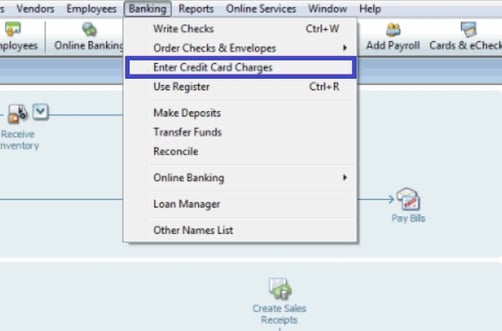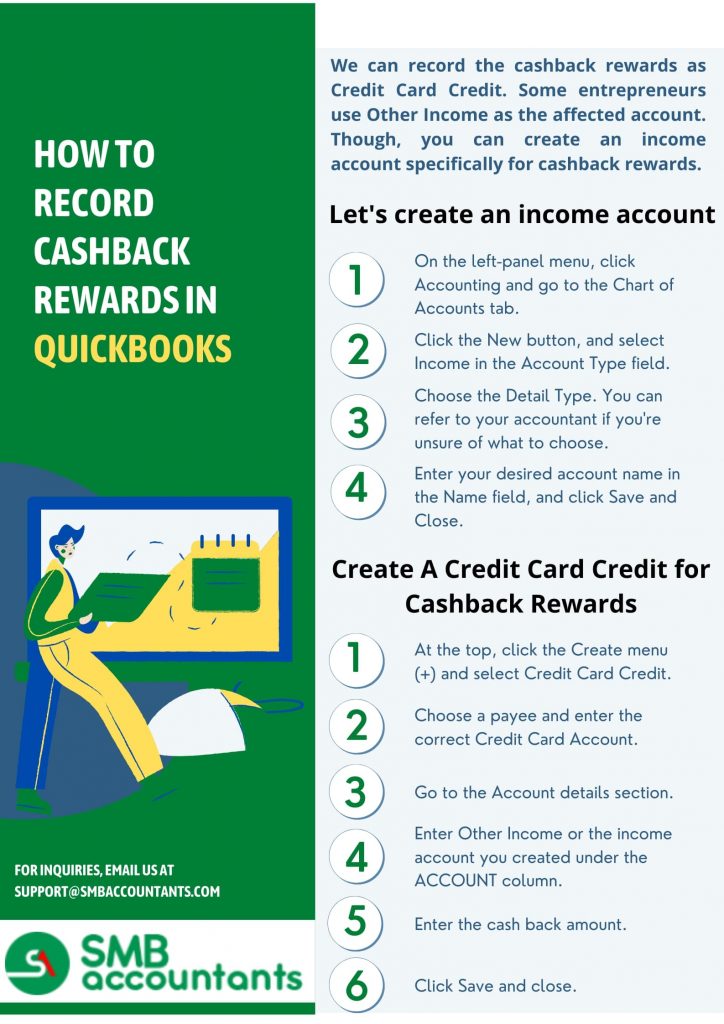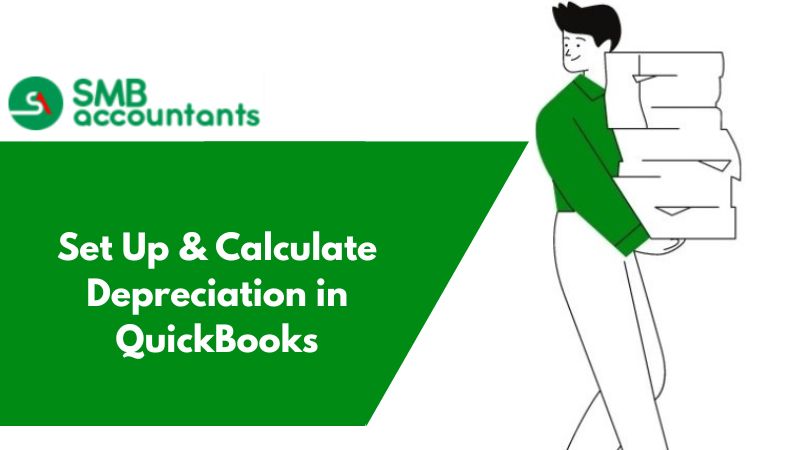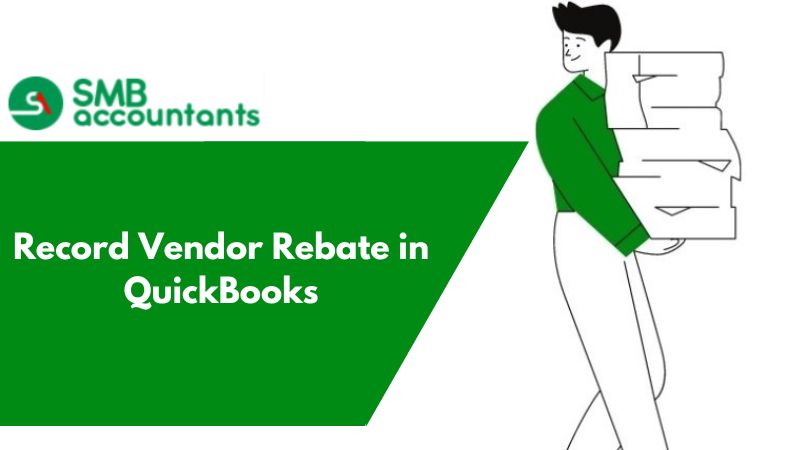What are Cash Back Rewards in QuickBooks Desktop?
A Cash Back Reward is nothing but an income when you receive it. It is posted to other income and it doesn’t matter how you use it. Based on the purchases, Cash Back Rewards should be counted as discounts/adjustments to the purchase price, not as income.
When you get a new credit card, which can give you cash back on some percentage of the amount spent by you, now the question arises of how to show this transaction of refunds in QuickBooks. You can solve the issue by following the below-mentioned two approaches:
To understand it better let’s take an example: a trip was taken by you and lots of money was spent on the airfare, so this reward refund could easily be applied to the same category of travel expense, which was used originally for the transaction. The transaction could further be split into multiple expense accounts.
The problem that is associated with this approach is that at the end of the year, you won’t have the true analysis of the expenses, as it will appear that less was spent by you than you did.
The statements credits or cash back that you get on your credit cards go here. Refund is classified by it as an income, but it won’t be a part of the Gross Receipts, hence it is not going to have any impact on the revenue analysis.
Easy Steps to Record Cash Back Rewards in QuickBooks Desktop
The cashback rewards can be registered as a credit card. Many businessmen or entrepreneurs use other revenue as the affected account. You can create revenue specifically for cashback rewards through you.
How to Export QuickBooks Customer List in Just 7 Easy Steps?
- Initially, go to Accounting and then click on the Chart of the Accounting tab.
- After that select the New button and choose an appropriate income in the field named “Account Type”.
- Now select the detail type.
- In case, you are not what to choose then you can take advice from your accountant.
- Next, enter the appropriate account name in the appear name field.
- At last, hit the Save button and then close the tab.
- The very first, select and click on the Create menu with a symbol (+).
- Next, at the top, you can see the credit card option.
- Select the Payee option and enter the accurate credit card account.
- After that enter the relevant account details.
- Now under the account columns, you need to enter other income or the other account that you’ve created.
- Once you’ve done with that then enter the amount for cashback as well.
- In the end, hit the save button and then close the tab.
Now You Can Easily Record The Cash Back Rewards with The Help of the Following Steps
- Open Banking Option: First, Go to the Banking option.
- Click on the Credit Card Charges Option: Next, select and click on the credit card charges option.
- Enter Appropriate Name: Now enter the appropriate name on the purchased field type.
- Select The Amount: After that select the amount that you’ve created.
- Enter The Charge Amount: Along with that, you have to enter the charge amount as well.
- Hit The Save Option: At last, hit the save option and then close the tab as before.
Also Read: How To Unvoid A Check In QuickBooks
How to Record Cash Back Rewards in QuickBooks Desktop/Online/Pro?
Users can record their cash-back rewards as credit cards. As the amount affected, some businessmen or entrepreneurs use other income. So, to record cash back rewards, users can create an income, especially for that.
Here are the Steps to Create an Income Account
- Initially, click Accounting and move to the “Chart of Accounts” tab
- Next, hit the New button and select the Income within the field named Account Type
- Now, select the Detail Type or if you’re not sure then consult your accountant to choose the appropriate one
- After that, enter the appropriate account name in the relevant field
- At last, hit Save and then close the tab.
Now, you need to create a credit card for your cashback rewards
- The very first hit the create (+) menu
- Next, at the top of the menu select the Credit Card
- Along with that, select the Payee
- And then enter the appropriate credit card account
- After that, enter the information related to the account
- Along with that, enter other income or the other that you have created under the columns of the account field
- Now, enter the amount of the cashback
- Finally, hit save and then close the tab.
Once the above process is done then you are ready to record the cash back credit rewards with the help of the following steps:
Record the cashback credit rewards
- Firstly, go to the “Banking” section
- Next, pick the credit card charges option
- In the purchased field, you have to enter the name
- Along with that choose the created account
- Now, enter the charge amount
- And lastly, hit Save and then close the tab.
How to Categorize Cash Back Rewards in QuickBooks Desktop?
You can categorize the Cash Back Rewards on QuickBooks Self-Employed. Generally, you get the Cash Back Rewards from your credit card account which is not usually a part of your business income so you can categorize the downloaded transaction as personal within your computer.
Here Check Out The Different Categories
- Assets
- Business income
- Car and truck
- Commissions and fees
- Healthcare
- Home office expenses
- Interest paid
- Supplies
- Office expenses
- Personal deposit
- Personal withdrawal
- Taxes and licenses
- Travel
Some of The New Categories Added
- Advertising- Listing fees
- Car and truck- Vehicle loan
- Commissions and fees- Referral/ broker/selling fees, Transaction/processing fees
- Insurance- Other property insurance
- Interest paid- Business loan, Mortgage
- Home office expenses- Mortgage (home office)
- Rent and lease- Equipment rent and lease
- Other expenses of business- such as Memberships/subscriptions, Uniforms, Computers, Furniture, and more.
How to Enter Credit Card Cash Back Rewards in QuickBooks Desktop?
By following these two methods below, you can learn how to enter credit card cashback rewards in QuickBooks.
Method 1: Entering Cashback via List Menu
Need a few methods of recording the cashback of your credit card in QuickBooks you first go to the top menu bar and select List. After that make your way to your chart of accounts and select the account option soon choose any income option. It will be recorded in QuickBooks as a cashback reward.
- First, you open the QuickBooks.
- After that, you click on the top menu.
- Then click on the list here.
- now go to the chart of accounts.
- Now push the drop-down given with Account and select New.
- Then select the types of other accounts.
- Here, select the option of “Other Income”.
- Then click on Continue.
By following the above steps carefully, you will have entered credit card cashback in your QuickBooks account.
Method 2: Using the Banking Menu for Recording Cashback
A banking menu has been given to the QuickBooks software. Opening this menu shows the credit card charge. This option helps the user to quickly record/enter the cashback reward received from his card. The Save and Close button should be pressed to finally consolidate the typed information.

- Begin the process by opening the QuickBooks.
- Now, use "Banking".
- Title for "credit card fee" option.
- Here you will be asked to type the appropriate name for it on the Purchase field type. write the name.
- After naming you choose your cashback amount.
- Also, create the charge amount.
- Then, click on the Save and Close option.
Add Credit Card Cashback Rewards in QuickBooks Desktop
To know how to add credit card cashback rewards to QuickBooks desktop, first open it. After opening, select the Banking section. Then go to the purchase field and add your name. After adding the name, click on the Create Account button, and the account will be ready. Then save your cost amount by keeping it at the relevant place.
- Launch "QuickBooks Desktop".
- Open the "Banking" section.
- Put your name in the "Purchase field" option.
- Make sure your account has been created
- Keep the cashback amount at the relevant place.
- Save this data.
- Now close the software.
Issues Users Face While Entering Cashback Rewards in QuickBooks Desktop
Issues that may arise are:
What expense can be used for the amount of cash back on the Debit Card and what can be written in the field of Description, this happens when the user does not know where the money was spent.
The Second Problem that users encounter is, How credit card Cash Rewards are recorded in QuickBooks.

Another situation could be that users are using a credit card to make purchases and to get cash back when they pay from the same credit card. What the user wanted to know here is how the cashback is going to be recorded in QuickBooks.
How to Record Cash Back Rewards In Accounting
How to account for credit card cashback rewards in QuickBooks
Many organizations frequently employ credit card rewards programs as a means to manage expenses effectively and enhance their financial performance. Clients often question whether they must consider credit card rewards when it comes to taxation implications. Credit card agreements can differ significantly, and we strongly advise meticulously examining the terms while also seeking guidance from your accountants when navigating choices for your organization.
The initial task involves identifying the nature of your rewards. When you opt for a credit card, you typically encounter two varieties of rewards: points and cashback incentives.
CASH-BACK REWARDS
Cash-back rewards are typically easier to handle from an accounting perspective compared to points rewards because they possess a straightforward dollar value, directly correlating with the amount you spend. The treatment of your credit card cash-back rewards, including considerations of materiality, will dictate whether you should recognize them as earned immediately or defer recognition until they are redeemed. In practical terms, many organizations choose not to record unclaimed cash back or rewards on their balance sheet or financial statements until they are used. Alternatively, some organizations opt to recognize these rewards in a lump sum at the close of the reporting period, encompassing the total rewards earned during that specific reporting period.
In many instances, tracking and accounting for individual credit card rewards becomes impractical. Cash-back rewards are also subject to waiting periods or spending thresholds that some banks may impose before they are redeemable. Consequently, organizations generally opt to record cash-back rewards when they redeem them in a consolidated lump sum, as outlined below:
| ACCOUNT | DESCRIPTION | DEBIT | CREDIT |
|---|---|---|---|
| Cash | Redeemed cashback | $XXX | |
| Earned Cash Back (Expense/Revenue)* | $XXX |
Just like any accounting decision, leaders must consistently factor in the significance of rewards concerning the organization's complete financial statements when deciding how to account for them. In terms of materiality, Auditing Standards (SAS) No. 138 underscores that "Misstatements, which may include omissions, are deemed material if there is a substantial probability that, either individually or collectively, they would impact the assessment made by a reasonable user relying on the financial statements."
Using a spectrum from material to immaterial, if the rewards acquired in a reporting period hold notable significance, either individually or combined, in the context of the overall financials, it is advisable to meticulously monitor and account for rewards earned with each purchase. Alternatively, at the very least, it's essential to track and record the total sum acquired after each reporting period. However, if these transactions, either on their own or in total, don't significantly affect the financials, your organization may find it more feasible to record cash-back rewards upon redemption.
If an organization opts to record the credit card rewards earned for each purchase or as a lump sum at the end of each reporting period, the corresponding entries would be as follows:
POINTS
Assigning a value to credit card points earned can be a more intricate process, requiring a thorough examination of the terms outlined in your credit card points agreement. Credit card issuers often employ different multipliers for various categories of purchases, which can result in distinct values for each type of transaction, and these values may also undergo fluctuations over time.
SIGN-ON BONUSES
The bonuses received for enrolling in a credit card company's card program should be accounted for as other income at the time the agreement is finalized. The taxability of these sign-on bonuses depends on their association with spending. If you receive a sign-on bonus without any mandatory spending requirements, it is regarded as taxable income. However, if the sign-on bonus is contingent on reaching a specified spending threshold within a defined period, it is not considered taxable income. The majority of credit cards typically entail some spending prerequisite to earn the sign-on bonus, rendering it non-taxable.
TAXABILITY OF REWARDS
Typically, rewards earned from business credit cards are viewed as rebates on purchases rather than taxable income. Hence, they are not subject to taxation. Nevertheless, it's important to note that the IRS might deem certain reward programs as taxable income.
If using the earned points does not necessitate a purchase, these points are typically deemed as taxable income. In cases where the accrued points' value exceeds $600 within a year, the credit card company is obligated to report this income to the IRS and issue a 1099-MISC form to the customer.
The IRS categorizes cash-back rewards as spending rebates rather than taxable income. As a result, you are not obliged to pay income tax on these rewards. For businesses that receive cash-back rewards or gift cards, a reduction in the business deduction for the items purchased using the rewards credit card is appropriate.
NAVIGATING CREDIT CARD REWARDS
Credit card rewards present organizations with a useful means to handle expenses, yet the accounting and tax aspects can pose complexity. Cash-back rewards can be documented upon earning or redemption, considering their material significance. The assessment of point values is complex due to differing multipliers. The taxability of sign-on bonuses may hinge on spending requisites. Typically, business credit card rewards do not incur taxes, but exceptions may apply to specific programs. It's essential for organizations to carefully examine terms, seek advice from accountants, and factor in tax regulations for employee rewards. Acquiring a clear understanding of these implications ensures precise accounting and adherence to legal requirements.
There might be other situations as well, apart from what is mentioned by us above, where you may feel stuck or unable to get the appropriate solution. So, to get the desirable and correct answer to all your queries, you can anytime get in touch with smbaccountants.com. SMB product help professionals are very well aware of the workings of QuickBooks and can handle all your queries with great ease.
Frequently Asked Questions
What is Cashback in QuickBooks Desktop?
QuickBooks Online's method of tracking cashback rewards is almost similar. You should follow up on the points before you use them. Such rewards are revenue for the company either by using them as a credit that decreases the balance or by receiving a check and making a deposit.
Most credit card rewards are not taxable, but watch out for those who do not have the expenditure threshold needed to redeem the rewards. Although these cards provide a benefit up front, you will be expected to report such benefits as income later when you file your taxes.
Usually, the cashback rewards that you receive from your credit card account are not part of business revenue. Within the system, you may categorize the downloaded transaction as Personal.
According to the seller's accounting, cashback is accrued by debiting cost accounts, for example, accounts 44 "Sales expenses", by the following entries: 44-62(76) - the buyer's bonus is accrued; 62 (76)-51 - the buyer's bonus is paid.
Generally, credit card cash-back rewards are not taxable. The IRS considers cash-back rewards to be rebates on spending and not income, so you will not have to pay income tax on them.
- Select + New.
- Select Credit card credit.
- Find the appropriate account from the Bank/Credit Account drop-down box.
- Under the Category details, select the account that you have for your cash back rewards whether expense/income account as you see fit.
- Enter the other needed information.
How do you record credit card rewards in accounting?
To include credit card rewards in your accounting records, you can log them within the "Other Income" or "Credit Card Credit" sections of accounting software like QuickBooks.




